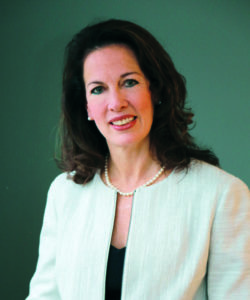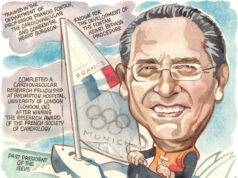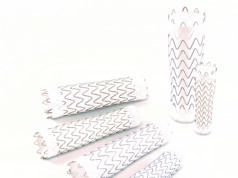 “As vascular surgeons, we never stop learning,” Palma Shaw tells Vascular News. This is one of the key attractions of the specialty for Shaw, who recalls various aspects of her career to date—from her early days learning endovascular surgery from Frank Veith to impacting the learning of others and addressing disparities in education across the globe in her role as secretary general of the World Federation of Vascular Societies (WFVS).
“As vascular surgeons, we never stop learning,” Palma Shaw tells Vascular News. This is one of the key attractions of the specialty for Shaw, who recalls various aspects of her career to date—from her early days learning endovascular surgery from Frank Veith to impacting the learning of others and addressing disparities in education across the globe in her role as secretary general of the World Federation of Vascular Societies (WFVS).
Why did you decide to pursue a career in medicine and why, in particular, did you choose to specialise in vascular surgery?
I have always had an interest in science and helping people live better lives. Medicine felt like a way to combine this and provided the intellectual challenges that I needed. My interest in surgery began in high school when I met a female plastic surgeon and spent time with her on rounds. I thought, wow, women can be surgeons too. In medical school I was exposed to vascular surgery and became captivated by open aortic aneurysm repairs and carotid endarterectomies. The process of repairing something that is broken or flawed to restore its integrity appealed to me. I remember as a medical student viewing the vascular surgeon as the hero who is called to stop bleeding during an emergency—so cool, calm and collected. I wanted to be like them.
At the end of my general surgery training, I was exposed to the wonders of endovascular surgery. This was magnified by my most impactful year of learning with Frank Veith, who opened my eyes to the innovation and benefit of this new technology. My formal fellowship with Bruce Brener allowed me to apply much of the knowledge I had acquired. Endovascular techniques became a natural complement to vascular patient care. I could offer my patient the best care with either an open, endovascular or hybrid approach. As vascular surgeons, we never stop learning. My first job at Boston Medical Center gave me a deeper understanding of limb preservation with Gary Gibbons as my mentor. I welcomed the challenge of the diabetic foot and vascular disease, which is the source of high limb loss rates. I enjoy the collaboration required to form a multidisciplinary team in addressing this ever-growing clinical problem.
Who have been your career mentors?
My first mentor in vascular surgery was Frank Veith. His teachings have formed my career. I learned resilience and tenacity from him. His commitment to the best care of the patient and viability of our specialty inspired and guided me. My first partner in practice, Gary Gibbons, a maven in diabetic vascular disease, taught me many techniques for limb salvage and distal bypass surgery that I still use today. Amy Reed was my first real female surgeon mentor. She showed me how to be a leader of women among men in vascular surgery. Linda Harris, a true educator and leader, has inspired me to take on leadership roles in different societies. I have been blessed to have these wonderful mentors and sponsors during my career.
What has been the most important development in vascular surgery during your career to date?
The evolution of the endovascular repair of aortic pathology has decreased the morbidity associated with abdominal aortic aneurysm (AAA) repair and allowed those unfit for open surgery to have a durable repair. This option has an even greater impact on thoracic aneurysm repairs and intervention for thoracic aortic dissection.
How would you like to see the field develop over the next decade or so?
A balance needs to be reached between cost of care and quality of care. The durability and efficacy of interventions needs to be considered as endovascular interventions are performed more often and by a variety of interventionalists. In addition, a patient-centred approach will provide the best outcomes. Optimal medical care and an informed decision considering the patient’s goals should continue to be emphasised in our day-to-day decisions. Repeat interventions that do not offer long-term benefit should be avoided. Often patients are given false hope, which drives up the costs of care. I hope that we can find ways to provide the best fit for procedure and patient. Finally, more research is needed to define the best treatment of underrepresented minorities and women as many clinical trials have not enrolled adequate numbers. I anticipate better clinical trials with more women and underrepresented minorities as primary investigators.

What are the biggest challenges currently facing vascular surgery?
One of the biggest challenges is branding and the recognition of the vascular surgeon’s role and our contributions to society, and another is the rising epidemic of limb loss due to diabetes mellitus and downstream effects of the delay of care due to the pandemic.
What are your current areas of research?
My current areas of research are management of acute limb ischaemia and the evolution of management with new technology, and also limb preservation for chronic limb-threatening ischaemia.
In the last year, which new research paper has caught your attention?
The recently published paper by Brajesh K Lal et al entitled “Evaluating the optimal training paradigm for transcarotid artery revascularisation based on worldwide experience” (Journal of Vascular Surgery 2022; 75:581–9) caught my attention. This paper demonstrates that there are methods of training for transcarotid artery revascularisation (TCAR) which can effectively use cadavers or synthetic models to achieve dissemination of this knowledge and skillset similar to training using proctoring on live cases. Optimistically, this brings hope to the challenges we now have related to the halting and reduction of case volumes secondary to the pandemic which have impacted our trainees and young surgeons.
What have been the highlights of your role as secretary general for the WFVS so far, and what further goals do you have?
My involvement with the WFVS as secretary general has given me a wonderful opportunity to collaborate with leaders in the global vascular community. I joined at a time of transition in the middle of the pandemic when this federation needed to evolve into something more purposeful and modern. The executive council and the council members representing the different societies have redefined our mission, created new bylaws, realigned the website and defined future projects which are in line with our mission. The goal is to improve the quality of care for vascular patients worldwide by providing a forum for the international exchange of scientific and educational knowledge related to the diagnosis, treatment and prevention of vascular diseases. We plan to address disparities in education by exploring alternative methods including access to a virtual educational programme and exploration of training paradigms which can help teach on a global scale. Limb preservation globally is a concern and collaboration between the WFVS and the Japanese Society for Vascular Surgery will expand the opportunity for trainees across continents to participate in their Distal Bypass Olympics remotely. Future projects involve assistance to underserved nations with too few vascular surgeons to offer them virtual education, communication through the WFVS Connect online and helping to align those interested in hands-on training to travel to other parts of the globe to learn new techniques. We can provide networking for the future vascular leaders of the world.
Could you talk a bit about your involvement in the new Women’s Section of the Society for Vascular Surgery (SVS)?
More than 20 years ago I decided to pursue a career in vascular surgery. I found very few female mentors at that time. We had no one to ask about how to manage our time if we wanted to have a family. We were afraid to speak up and ask to have the same opportunities as the men. Over time, pushing through many barriers, I met other women in vascular surgery who have fought similar battles. At this time, the SVS has committed to be supportive of diversity and equity. Women can be women, mothers and vascular surgeons. One of my mentors, Amy Reed, suggested that we form a section within the SVS to provide a more formal network of women who can help each other reach our potential. I founded this with Amy Reed, Linda Harris and Audra Duncan. We plan to hold our first session at the Vascular Annual Meeting in Boston this year. The theme is “Supporting women vascular surgeons: from recruitment through senior leadership”. This is very special as it appeals to female surgeons in late, middle and early career, as well as those in training. It is unique as many networking opportunities focus on the younger surgeons. This will benefit all and we will learn from each other. We hope to expand this throughout the SVS membership and already have interest from women in our international chapters. We approach this with open arms welcoming all SVS members who want to support women in our journey towards excellence.
What are your hobbies and interests outside of medicine?
My interests include spending time with my family, skiing, exercise and travel.













